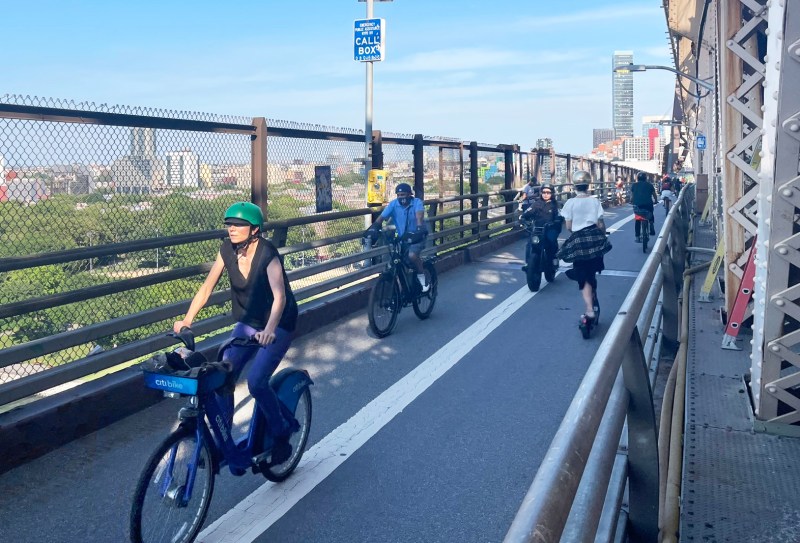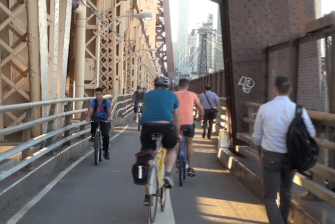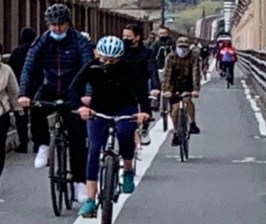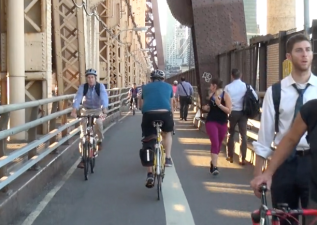EYES ON THE STREET: Walking Across the Queensboro Bridge is So Dangerous, It Feels Illegal

How dangerous, cramped, congested and frightening is the Queensboro Bridge’s notorious shared bike and pedestrian path?
Let’s put it this way: it feels illegal to be up there on two feet.
The other day, Streesblog encountered two tourists, plus a native New Yorker, walking on the path who were convinced that the shared path must only be for bikes and mopeds — because no government would place citizens on foot in such potential harm.
In fact, they needed to be convinced that they were on the actual assigned pedestrian route between booming Midtown Manhattan and Long Island City.
“We thought we weren’t supposed to be walking there,” one of the pair said.
Her traveling companion added, “It seemed just like a bike only lane, but we just didn’t know where else to cross.”
And native New Yorker Alex Guevara, born and raised here!, couldn’t believe it either.
“This is my first time crossing the bridge, and I wasn’t sure if this was all just for bikes,” he said, noticing the perilous conditions on the the 113-year-old, once entirely car-free, bridge.
The danger and confusion is what everyone feels these days, thanks to a double-digit percentage increase in users of the mere 11-foot-wide lane, which is shared by cyclists and pedestrians in both directions.
In May 2022, the last full month for which the Department of Transportation has statistics, 168,961 people crossed the bridge on bike, wheelchair, or scooter, up 42 percent from May 2019. And, of course, injuries are up, too.
Though the city keeps terrible statistics of crashes on the existing shared path (partly because the city’s Open Data portal only has crashes that were reported to the NYPD, which stopped responding to non-injury crashes in 2020), in the three years between Jan. 1, 2017 and Dec. 31, 2019, one pedestrian and three cyclists were reported injured on the path.
During the same period over the successive three years, that number rose to nine cyclists injured. (Again, that’s not counting all the scratches from minor crashes that could have been much worse.) And the number of crashes caused by an moped or e-scooter rose from zero to seven.
Yet the city announced in February that it would delay its long-promised plans to create more sustainable transportation space on the bridge until at least the end of 2023.
So how’s that working out? We sent young reporter Noah Martz to the historic span the other day and he reacted similarly to those tourists. No one is safe on the shared path right now — the split bike lane is roughly 5.5 feet wide, which is far below the DOT’s own standards, which call for at least four feet in each directions of a two-way bike lane.
And every inch matters when it comes to transportation design (just ask the folks who run the seminal 11-foot-8 website), which is why the de Blasio administration had promised in January 2021 to turn the bridge’s South Outer Roadway into a full-time pedestrian path by the end of his term.
Mayor de Blasio didn’t make his own deadline. And a month after taking office Mayor Adams extended the deadline until the end of 2023, meaning that the hegemony of the car — nine lanes on the two-level double cantilever bridge are for motor vehicles, one-half for pedestrians and one-half for bikes— will continue. The two Council members who advocated for more space have been term-limited out, but their successors — Julie Menin on the East Side and Julie Won in Queens — are picking up the fight.
“It is unacceptable that DOT continues to maintain the South Outer Roadway as a low-volume motor vehicle lane,” Won said. “People walking or biking on the shared path are paying with bloody pavement and broken bones, all so the DOT can promote car travel for the few. Providing more space to walk or bike across the Queensboro bridge will reduce injuries and alleviate the constant traffic issues at Queens Plaza.”
Won said she has been in contact with DOT, but has not gotten any good news.
Walking on the bridge is a truly unnerving experience, as mopeds, scooters and regular bikes barrel directly towards pedestrians — especially at pinch-points caused by ongoing repairs:

Despite having nine dedicated car lanes, drivers still act entitled. At the pedestrian/bike lane entrance on 60th Street between First and Second, a traffic light forces pedestrians and cyclists to wait a full minute for motor vehicles to exit the bridge. This still doesn’t seem to be enough time for some drivers. Streetsblog witnessed cars repeatedly rolling through the red light, even when there was an NYPD Traffic Enforcement Agent on hand. One driver came close to hitting a woman on a Citi Bike as he tried to sneak through a red light; the collision was avoided only because the woman kept screaming, “Red light!” before the driver stopped.
While tourists walking on the pedestrian section of the bridge feel like they are criminals, illegal moped users believe they are following the law by using the bike lane. (As Streetsblog has reported, they are not.)
“I ride it on the roads, but going from Manhattan to Queens, I have to use the bicycle lane,” said Jeff, a moped user. “It would be unsafe to go on a highway with the cars.”
So instead, the pedestrian path becomes its own highway. And that ain’t right.
“I don’t like that the pedestrian path is delayed,” said Jim Schutte, a walker and bike rider who has lived for 30 years in the city, 20 of them in Queens. “So many people are uncomfortable walking here.”
We reached out to the Department of Transportation for this story, and the agency sent us the following statement from Commissioner Ydanis Rodriguez:
I am absolutely committed to putting a new and separate pedestrian path on the Ed Koch Queensboro Bridge and bringing the span into a state of good repair. This project is a priority for me, and I know New Yorkers are excited about it, so we are going to get it done properly and safely.
The agency reiterated that its primary commitment is to the structural integrity of the old bridge, which carries 160,000 vehicles per day. Once the reconstruction of the bridge is completed by the end of 2023, the South Outer Roadway will be converted to pedestrian space. The agency denied that the incoming Adams administration changed the timeline of the project, but that it was simply pushed back because of delays in the work of replacing the bridge’s upper roadway deck.
The agency did not explain the specific cause of those delays.



